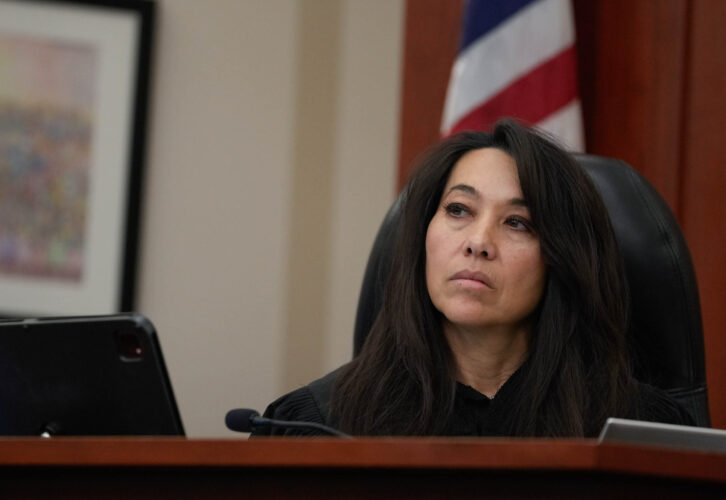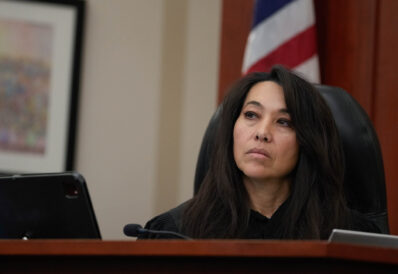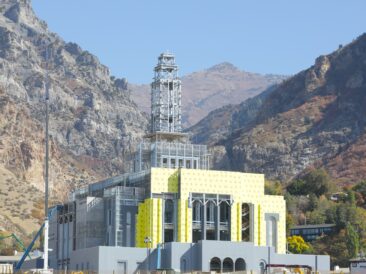Another redistricting twist: Utah GOP changes tactics to repeal independent map-drawing law
The group Utahns for Representative Government will now try to use direct democracy to repeal voter-approved Proposition 4. Meanwhile, lawmakers’ experts defend their maps in court

Francisco Kjolseth, The Salt Lake Tribune
Oral arguments are made from parties in Utah’s latest congressional maps process during day two of testimony, before Judge Dianna Gibson in Salt Lake City on Thursday, Oct. 23, 2025.Just as the second and final day of complicated map-drawing expert testimony came to an end late Friday, another twist cropped up in Utah’s court-ordered redistricting legal battle.
An attorney for Utah’s top election official, the lieutenant governor, told Third District Judge Dianna Gibson that the bid for an indirect initiative to repeal Proposition 4 — the 2018 voter-approved law that calls for an independent redistricting process — had been withdrawn.
“We are withdrawing this effort prior to initiating a direct initiative effort on the same issue,” Utah Republican Party Chair Rob Axson wrote in an email to the state’s elections director, Ryan Cowley sent at 4:15 p.m., just as Friday’s evidentiary hearing was wrapping up.
Now, rather than seeking about 70,000 signatures to require the Legislature take an up or down vote on repealing Proposition 4 — an approach the plaintiffs in the state’s anti-gerrymandering lawsuit have challenged in court as unable to undue Proposition 4, which was approved by more than 500,000 votes in 2018 — Axson and other members of the group Utahns for Representative Government are shifting gears.
Instead, they’ve submitted an application to pursue the same method that the group Better Boundaries successfully pursued to get Proposition 4 on the ballot in 2018 and look to repeal that law by another statewide vote.
In a statement issued Friday evening, Utahns for Representative Government — the group supporting Proposition 4’s repeal — said legal filings opposed to their effort “made it clear that the Lt. Governor’s Office would likely be forced to deny the indirect initiative application.”
“While we would have preferred to continue under the process provided by law, the time required to defend our rights and appeal flawed judicial decisions would have made it impossible to meet statutory deadlines,” the group said. “The Utah Constitution is clear: the authority to draw congressional districts rests with the people’s elected representatives — not with the courts and not with an unaccountable commission. We again call on all Utahns to stand against judicial overreach and defend the separation of powers outlined in our state constitution.”
Elizabeth Rasmussen, executive director of Better Boundaries, issued a statement Friday characterizing the withdrawal of the indirect initiative as a victory — for the time being.
“Once again, political insiders’ attempts to undermine the people’s voice and repeal Proposition 4 have fallen flat, at least for now,” she said. “This is a win in our ongoing fight to give Utahns the reforms they voted for in 2018. Proposition 4 remains the law of the land. Moving forward, we will continue to strongly oppose any and all efforts to undermine fair maps and the ability of voters to choose their politicians.”
Katharine Biele, president of the Utah League of Women Voters, one of the redistricting case’s plaintiffs, told reporters outside Gibson’s courtroom Friday that it was “wise” of Proposition 4’s opponents to abandon their indirect initiative effort — but she warned pursuing a ballot initiative is no easy task.
“They will find out just how difficult a real initiative is,” she said. “We went through that in 2018, and it was hard.”
In order to successfully get their repeal on the ballot, the GOP group will need to collect at least 140,748 valid signatures from registered voters across Utah while meeting specific thresholds in at least 26 of Utah’s 29 Senate districts.
Utah Democratic Party Chair Brian King, in a statement, called the group’s withdrawal an “embarrassing end to a pathetic last-ditch effort by the Utah GOP to create chaos.”
“Even with millions of dollars, the backing of Donald Trump, Jr., and support from high-profile elected Utah Republicans, they realized they still didn’t have the competence nor the public support to pull this off,” King said.
King was referring to Trump Jr., in a post on X earlier this week, urging people to sign up as signature gatherers for the indirect initiative effort.
“The Utah Republican Party may continue to try to ignore the will of the voters next year using other tricks. But Utahns will continue to see through the corruption, abuse of power, and overall disrespect,” King added. “We will be there to support everyday Utahns when it is time for that particular fight, but today we celebrate another win for voters.”
The GOP’s strategy shift comes as the state’s Republican leaders continue to protest Gibson’s earlier ruling that determined the 2021 Utah Legislature overstepped when it undid Proposition 4. As a result, she struck down the congressional map lawmakers adopted that year as a product of an unconstitutional process and she ordered a process to pick a “remedial” map in 2026.
In court, the Legislature’s attorneys and the redistricting lawsuit’s plaintiffs have submitted to Gibson their preferred maps — one known as map C that the Legislature advanced in a special session earlier this month, and two submitted by plaintiffs as alternatives. The judge faces a Nov. 10 deadline to pick a map in order for it to be ready in time for the 2026 elections.
In the courtroom, experts clash over mapping methods
Thursday and Friday, attorneys grilled each other’s redistricting experts while building their cases for why Gibson should pick their preferred maps.
Plaintiffs have argued in court documents that the Legislature’s retained map-drawing experts used methods unfit for a state like Utah that is dominated by the Republican Party while Democrats are concentrated in the densely populated area of Salt Lake County.
The Legislature’s experts, however, defended their methods during hours of testimony and cross examination on Friday — while also questioning the plaintiffs’ experts’ methods and whether they were evaluated for partisan slant with tests that favored allowing a Democratic-leaning district.
Friday, the Legislature’s attorneys called three experts to testify: Michael Barber, political science professor at Brigham Young University and director of the Center for the Study of Elections and Democracy; Sean Trende, senior elections analyst for Real Clear Politics; and Jonathan Katz, professor of social sciences and statistics at the California Institute of Technology.
Trende explained how he drew the Legislature’s map C, saying he based it on the 2021 map’s original boundaries but he sought to correct it to bring it more in line with Proposition 4’s neutral redistricting criteria.
However, because he said Proposition 4’s language explicitly calls for “measures of partisan symmetry” to be considered among the “best available” scientific methods, he said he felt he had no choice but to use what he sees as the only way to measure partisan symmetry: the partisan bias test.
The plaintiffs argue the partisan bias test is among the worst methods to use to measure fairness in a “lopsided” state like Utah where statewide races are won by Republicans with wide margins.
Trende anticipated there would be controversy over the method — saying he wished Proposition 4’s language didn’t call for it because he knew it would inevitably lead to a challenge and he didn’t want to end up in a courtroom like he has for many other redistricting legal battles. He went as far as calling it a “tragic addendum.”
“This is a trainwreck I saw coming the moment I read (Proposition 4),” Trende said. “I think the person who drafted this should be put in a cage and paraded around Salt Lake City.”
Nevertheless, Trende and another one of the Legislature’s experts, Barber, argued that their analysis of map C compared to thousands of map simulations showed the map wasn’t an “extreme partisan outlier,” as the plaintiffs’ expert Jowei Chen testified Friday. Instead, they argued it passed multiple tests analyzing for partisan fairness, while they said plaintiffs’ maps appeared to be the true outliers.
Barber said his analysis of Chen’s map simulations showed that “his algorithm is almost always producing a very Democratic district located in the northern half of Salt Lake County.” He said his own simulations produced comparatively more variety while using data that’s publicly available and peer reviewed, while Chen’s isn’t.
“To me this is a tell-tale sign of a biased algorithm,” Barber said. “The algorithm should be producing a representative sample of maps. We’re seeing a single orientation over and over and over again.”
While the plaintiffs have accused Trende of using a map simulation set that wasn’t programmed to prioritize Proposition 4’s neutral criteria, Trende argued he did his best to follow Proposition 4 while creating map C’s boundaries.
“I didn’t want to be here (in court),” he said with a laugh. “I was trying to draw maps that would easily comply with at least the structural requirements of Utah law.”
But while cross examining Trende, the plaintiffs’ attorney, Mark Gaber with the Campaign Legal Center, pointed out that multiple times Republican legislators expressed misgivings with accepting maps drawn on a platform called Dave’s Redistricting Tool with a partisan data view turned on.
During questioning, Trende acknowledged he drew maps using the tool, but he said the political data was “set to a useless composite” with data from 2012 to 2020.
What’s next?
The judge now has hundreds of pages of court documents with extremely complicated statistical analysis to wade through before picking a new map sometime before Nov. 10.
She has scheduled another hearing to consider oral arguments in the case on Nov. 4, Election Day.
That day, the parties are scheduled to debate another complaint filed by the plaintiffs urging the judge to block a law that lawmakers passed alongside their map submission that requires the use of three specific statistical tests that the plaintiffs argue lead to maps that favor Republicans over Democrats.
Another hearing scheduled for Nov. 5 was previously expected to debate the plaintiff’s legal challenge of the GOP’s indirect initiative, but given that issue is now moot, it’s likely that hearing will be canceled.



